Marina is Present
In 2010, Marina Abramović sat every day on a chair, from March 14 to May 31, for more than seven hundred hours. The performance, titled The Artist is Present, took place in the Museum of Modern Art (MoMA) in New York as a retrospective organised by the curator Klaus Biesenbach (MoMA, 2017). One at a time, the spectators were invited to sit in front of her and look into her eyes for as long as they wanted. Simple in the idea, powerful in terms of audience response. People were queuing, camping outside the museum for a chance to see Marina, to become part of the piece (Dorment, 2014). A lot of them left in tears (see Figure 1).
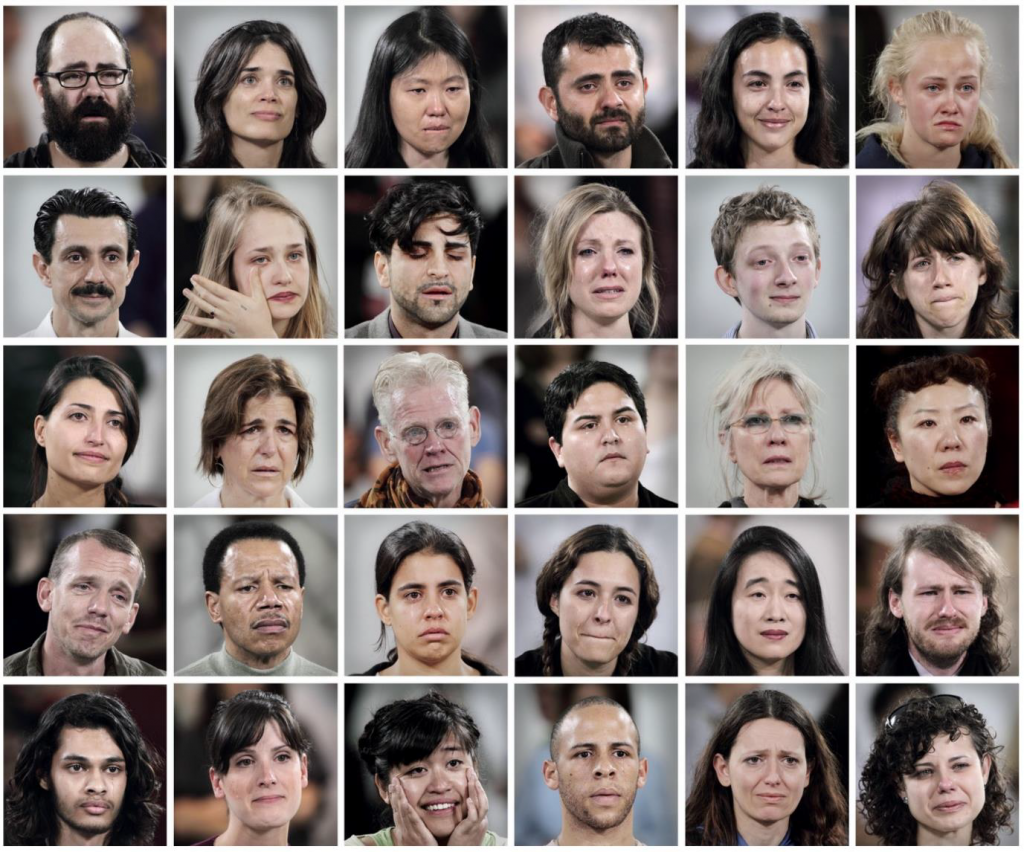
This essay will focus on the participative dimension of Abramović’s work, and, particularly on Marina Abramović Institute (MAI) and its relationship with her figure. Probably, The Artist is Present represents the event that better synthesises the passage of Abramović from being an artist acknowledged by the artistic community to becoming famous also for the general audience, turning, in a way, into a celebrity (Marcus, 2015).
Abramović was born in Belgrade in 1946, daughter of two ‘war heroes’ that fought for Tito. She was given an almost military education by her rigid mother, growing up with very little affection but with ample access to culture and, since very young, encouraged to pursue a career as an artist (Abramović, 2016). She enrolled in the Academy of Fine Arts, at first, focusing mainly on painting. In 1968, she actively participated in the student protests and joined a group of five undergraduates that gathered regularly to talk about art (Abramović, 2016). As news about avant-garde movements and performance art reached Yugoslavia, she became thrilled by the possibilities of this medium and started inquiring about the opportunity to perform in an art centre (Danto, 2010). Unfortunately, her proposals were all rejected. If on the one hand, her life seemed to settle with a marriage and a teaching job, on the other, she started exhibiting sound installations, moving finally from visual art into the domain of immateriality (Abramović, 2016). The leap into performance art was about to happen.
Live and Death
In performance art, the body is the medium of the artwork: the creations incorporate the artists’ actions, either live or recorded (TATE, 2018). During the course of the 20th century, those works inevitably tried to find their place into the art world, among more academic art forms such as painting and sculpture, while incessantly reinventing themselves (Rockwell and Cowger, 2014).
Starting from the 1910s, the Futurists brought to the stage the destruction of the sublime in their serate, offering often annoying and provocative performances that leveraged a hungry desire of participation, intrinsic to their audience (Bishop, 2012). Later, the anarchic nature of Dada—embracing performance at first in the form of cabaret, then bringing it out in public spaces—got rid of the ideological motivation as the only way to contemplate participation. It offered an alternative to both the nationalistic participation of the Italian Futurists and the revolutionary collectivism of the Russian mass spectacle (Bishop, 2012). Later, French surrealist Antonin Artaud proposed in 1938 a direct form of communication with the spectator with the Theatre of Cruelty. He wrote: ‘We abolish the stage and the auditorium and replace them by a single site, without partition or barrier of any kind, which will become the theatre of the action’ (Artaud, 1958, p. 96).
In the 1950s, Abstract Expressionism reminded the role of body actions that lie behind the production of traditional art: action painting well typifies this rediscovered kind of dynamism. Moreover, it also influenced the practice of the Happenings together with, among others, John Cage’s avant-garde compositions and the ground-breaking approach to dance of his partner Merce Cunningham (Bishop, 2012). As a result, the American Happenings, theorised by Allan Kaprow, moved against the conventional theatre aiming at introducing risk and fear to the audience, regularly involved in the creation of the works (Bishop, 2012). In the end, the history of performance is the history of spectatorship: the public is provoked, triggered, engulfed, pushed away, and liberated, but it remains inextricably connected to the idea of performance itself. More than ever, the audience is essential.
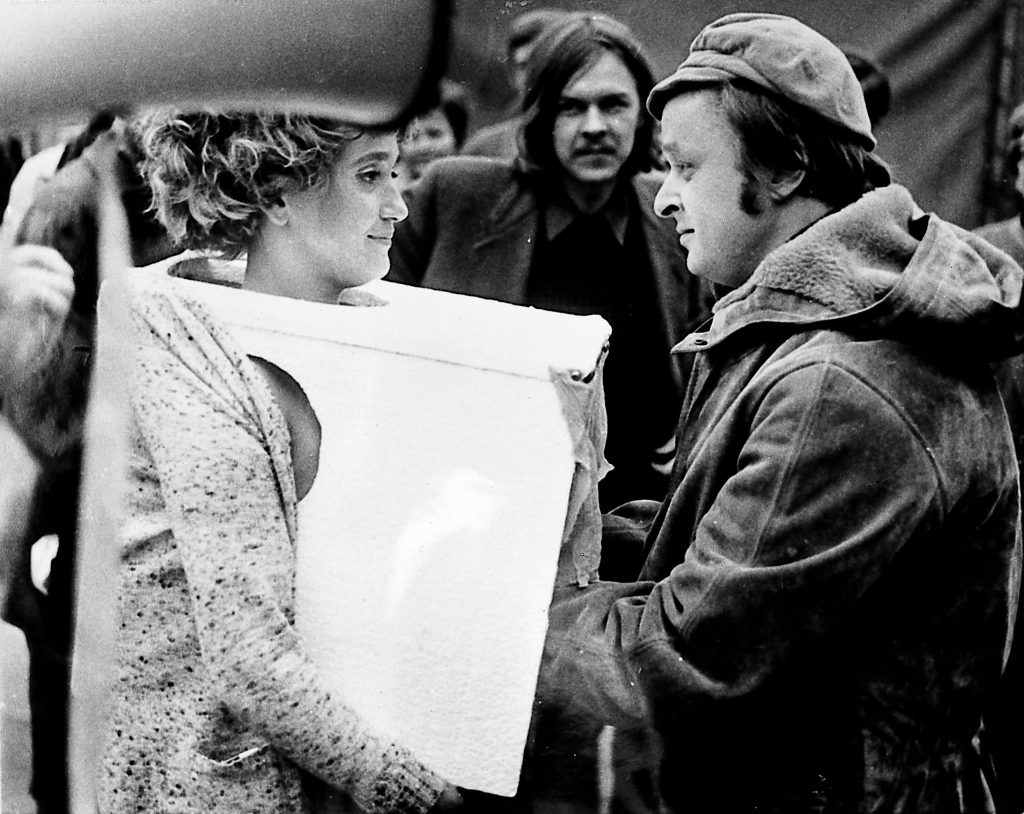
In the 1960s and 1970s, civil rights movements—especially second-wave feminism—promoting a discussion on sexuality, differences, and equality contributed to declaring that the body is political (Richardson and Sandland, 2000). For instance, VALIE EXPORT let the public touch her breast in Tap and Touch Cinema: a provocative reflection on the objectification of the female body (see Figure 2).
In these years, performance art started reflecting on the relationship between body and mind, exploring different states of consciousness to test what happens to the former when the event overwhelms thoughts (Phelan, 2004). Artists used their bodies to probe not only the relationship with the public but also with themselves, a personal reflection on ‘art and life, and life and death’ (Phelan, 2004, p. 17).
At the beginning of the 1970s, Abramović entered this discourse with works that tested her limits, both physical and mental. In fact, she often performed in extremely dangerous situations, playing with pain and revulsion. She cut her hand with knives and her stomach with razor blades (see Figure 3), she passed out owing to both lack of and too much oxygen, and she lost consciousness taking pills to cure schizophrenia (Demaria, 2004). If on the one hand, it is often the spectator that intervenes to save her, accessing the performative space, on the other, these are not proper interruptions since there are no rules or actual scripts that control the performance as it unfolds (Abramović, 2016). Anything seems to be possible and everything is real. Abramović explored her body to define herself: her naked body stood for Marina the artist, Marina the woman, Marina the daughter of the Yugoslav communism.
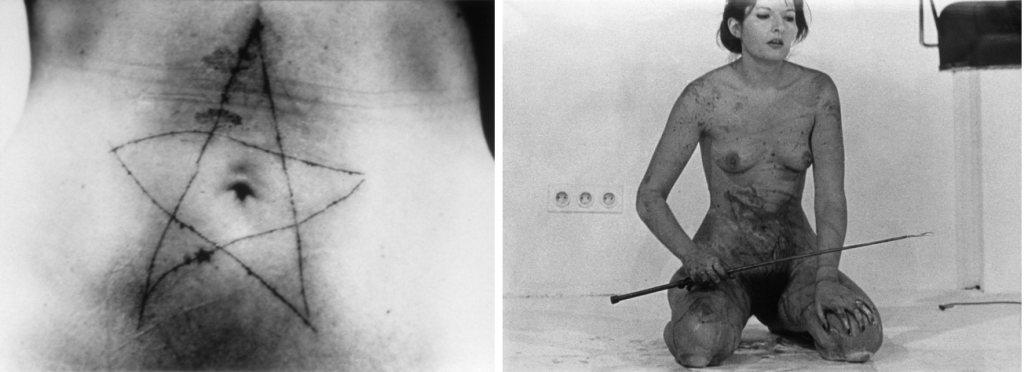
In 1975, when she met German artist Ulay, Abramović found herself, for the first time in her life, in front of the utterly powerful and destructive forces of an overwhelming love, both mental and physical. After leaving her husband and her country, she started an artistic and romantic partnership with him that would last for twelve years (Abramović, 2016). At first moving to the Netherlands, later living on a Citroën van across Europe, the couple started creating works ‘that kept the violence in the action […] and the audience was neutralised by being excluded from the circle of love” (Danto, 2010, p. 34). For instance, in Relation in Space, the two artists collided with each other at an increasing pace (see Figure 4).

The 1980s were the years of travels and explorations around the world. The first encounters with shamanism and aboriginal ritualism had an important role in what later became the Abramović’s Method (Abramović, 2016). In 1987, The Lovers represented the end of their working and personal relationship. The couple walked from the two opposite sides of the Great Wall of China and met in the middle, to bid farewell (Abramović, 2016).
The period after Ulay is both hard and characterised by a crescendo of success: a succession of travels, exhibitions, prizes, big installations, more travels, workshops, and collaborations with other art forms. International recognition expanded, and finally, after a Golden Lion at the Venice Biennale for her piece Balkan Baroque in 1997 (see Figure 5), The Artist is Present opened in New York in 2010 (Abramović, 2016).
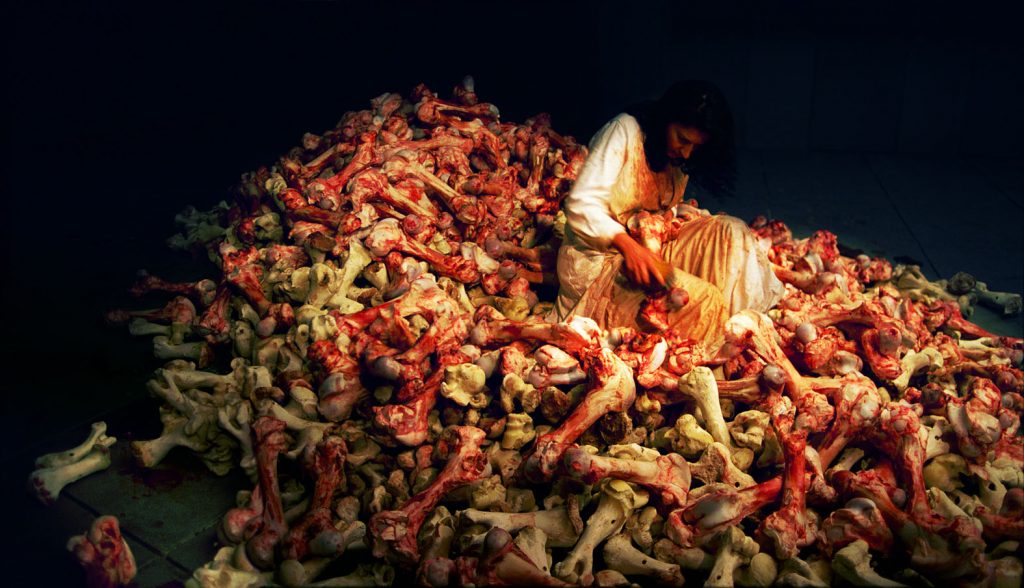
In The Artist is Present, the dialogue is not only between the artist and the audience, seen as a homogeneous unit, but it is especially a relationship among individuals. The space between the spectators and the performer is abolished, it becomes one as in Artaud’s ‘theatre of action’. The public is transformed into a ‘performance audience’ and new bonds are created also among the people, witnesses of the same piece (Danto, 2010, p. 35). The spectator becomes a performer and, in turn, the performer becomes a spectator. Moreover, they are both observed from the outside by the people in line (see Figure 6).
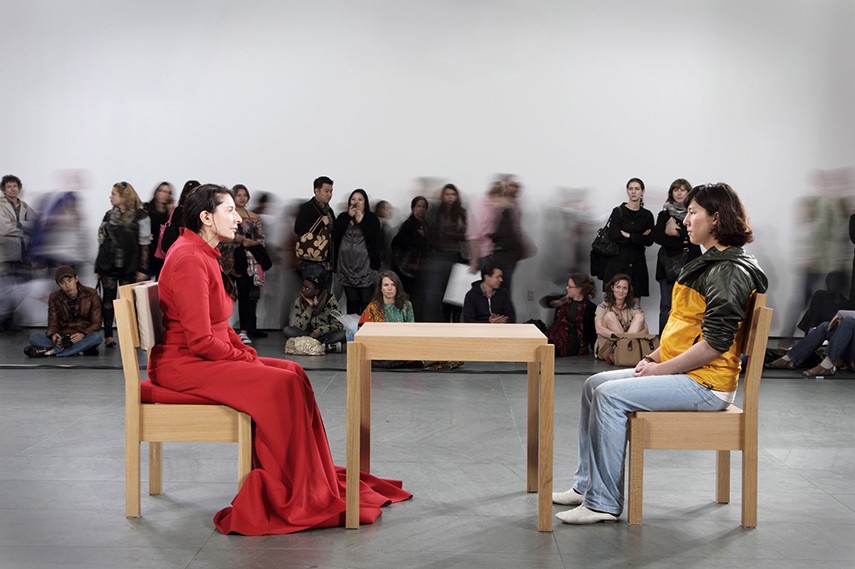
When Abramović stood up in front of the audience after three months of performance, she realised that the experience had changed her future production. Hereafter, she decided to create pieces for the community, using the transformative power of long durational performance to engage the people with the potential of immateriality (Abramović, 2017). Inspired by the ideas of Alexander Dorner, highlighting the need for a new kind of art institution more similar to a power station than to a museum, she devised the creation of an Institute for performance art (Abramović, 2017; Dorner, 1958).
Imponderabilia
The Marina Abramović Institute aims at preserving and presenting long durational works of performance art and, more generally, of performing arts. In a way, it will represent Abramović’s legacy to new generations of artists and to ordinary visitors. Moreover, it will also contribute to the development of new creations through collaborations with young artists and the promotion of an intertwined participation of the arts with science and spirituality (Kickstarter, 2018).
In 2013, after Abramović acquired the building of an old theatre, nearby New York City, a crowdfunding campaign was launched to cover the costs of the design of the new Institute (see Figure 7), which was commissioned to architects Rem Koolhaas and Shohei Shigematsu (Kickstarter, 2018). More than $660,000 were collected and various experiences were promised in exchange, ranging from hugs, given by Marina during a performative event, to exercises of the Method, and even a dinner with her (Kickstarter, 2018). Despite the $2.2 million raised from different sources, she later announced the decision of abandoning the project since the sum asked by the architects had raised from the initial $20 million to $31 million (Ruiz, 2017). The New York Post questioned her about the donations, accusing the artist of lack of transparency for not paying donors back and for not having delivered some of the rewards (Vincent and Klein, 2017). Abramović answered that the money was completely used to pay for the plans, exactly as stated on the crowdfunding platform. Furthermore, over half of the total sum consisted of her personal contribution—around $1.1 million plus the value of the building purchased—and she specified that some rewards were not sent because donors did not provide the delivery information (Hilburg, 2017). Between rumours, accusations, and overpaid starchitects, the discourse deals more with gossip than facts. In the end, MAI, leveraging on the immateriality of the artworks it will promote, decided to change its slogan into ‘Don’t come to us; we come to you’ (Abramović, 2017, reconstructed from the talk).
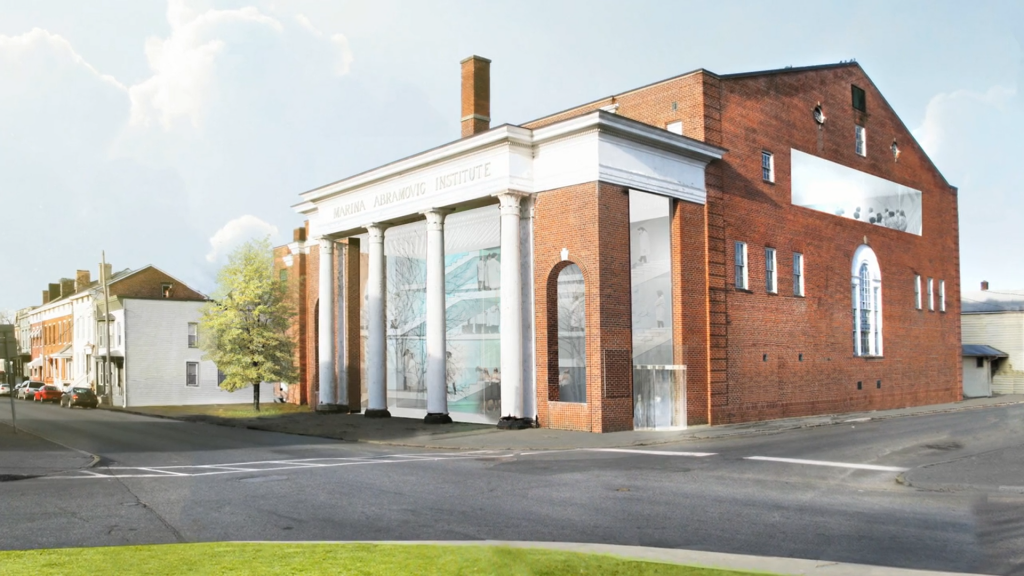
Currently, the Institute is a moving organisation, hosted by other venues, and it offers temporary exhibitions around the world. MAI wants to provide both some mental practices to the visitors and produce new long durational works, the former being, in a way, a training to experience the performances displayed (MAI, 2018a). At the same time, the exercises offered becomes performances: works in which the spectators constitute the actual artwork (Abramović, 2017). Therefore, the collaboration with the international venues has often been limited to these meditative activities and the whole formula has been realised solely in São Paulo and Athens, respectively in 2015 and 2016 (MAI, 2018a). MAI has organised thirteen art experiences, usually free of charge. Hundreds of thousands of people have participated in these events (MAI, 2018c).
Indeed, the starting point of the Institute is the Abramović’s Method, made up of the same exercises used by the performance artist to train herself and develop her artistic process (Kickstarter, 2018). The exercises have been tested and developed in previous exhibitions and they chiefly want to offer people a communal experience (MAI, 2018a). In more detail, the basis for the definition of the Method was the performance 512 hours, held at The Serpentine Galleries in London in 2014 (Abramović, 2017). Following the display of 512 hours, the experience starts with people depositing their mobile phones and watches and signing a form committing to stay for four or more hours in the venue. Some of these practices consist in: walking in slow motion, staring into each other’s eyes, sitting on chairs in front of crystals, and counting and separating rice from lentils (Abramović, 2017).
An interesting section proposed is built upon a situation of sensory deprivation. The audience is blindfolded and equipped with noise-cancelling headphones (see Figure 8). People are invited to explore the space in a vulnerable state, opening up to the unexpected and reflecting on the concept of ‘nothingness’ (MAI, 2018b). As she managed to stop New York City with The Artist is Present, freezing the atrium of MoMA and bringing stillness in a chaotic world (Abramović, 2017), her new idea of participation it is one that takes out the action, assuming, unexpectedly, a non-participatory connotation. The public does take part in the piece—it becomes the piece—without aiming at being seen by an external audience, but attempting to disappear. Although, this search for disappearance has nothing to do with the destruction of the self: it is conceived as a practice that enables to reach a wider form of awareness and catharsis. Surely, there are a few rules that govern the space of practice. For instance, silence is required throughout the whole process. Nevertheless, people can stop at any moment, observe the others, or leave (Abramović, 2017). Moreover, everyone is free to find its personal way to accomplish the task and guide its own introspective analysis. Abramović, slowly removing herself from her works, empowers the audience as the ultimate creator of the artwork and, simultaneously, asks the spectator to do nothing.

The artist, the work, the others
In a gallery in Naples, in 1974, seventy-two objects lay on a long table. Some of those were a candle, a brush, some bread, some wine, a rose, a knife, a bullet, and a gun. A twenty-eight-year-old Abramović was the seventy-third object. The performance Rhythm 0 asked the public to take complete control of the event, with sheer freedom, visitors were invited to use the objects as they wanted. Abramović took full responsibility and acted as a puppet for six hours (Phelan, 2004).
People, initially hesitant to participate, started playing with her, writing with a lipstick on her body or giving her the rose. As they became more confident they cut off her blouse, cut her neck and drunk her blood, pinned the rose in her flesh, put the bullet in the gun and pointed the gun at her head (see Figure 9). The gallerists intervened and got rid of the weapon, then, at the end of the performance when she started moving again, the public left the gallery as quickly as possible, almost frightened (Abramović, 2016).
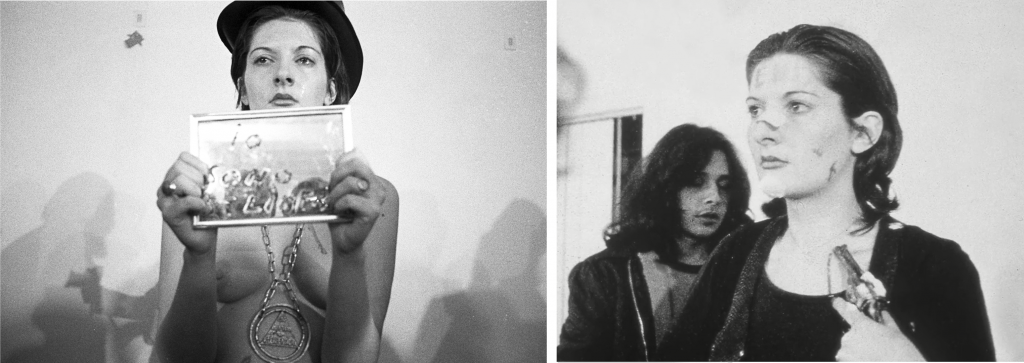
The participation in Rhythm 0 is pushed to the extreme: all the action is produced by the spectators, whereas the performer is subjected to them. Performer and spectators co-create the event and are both confronted by the consequences of their roles (Phelan, 2004). If participation in this piece lies in the freedom of doing, in The Artist is Present and in MAI’s practices, the participative component is ascribed to the freedom of non-doing or of doing less and less. A kind of participation that challenges the idea of participation itself.
The impossibility to forecast what might happen, or better, what should happen, make the visitors questioning their participation. Sometimes, as people walk blindfolded, they attempt to define what is right and what is worth doing (Ken, 2014). While looking for a meaning in their participation, they forget that the ultimate meaning is their mere participation: they are the only sense makers of the event. Furthermore, some participants have described the sensory deprivation experience as both soothing and uneasy: something that forces to face social anxieties and to focus on one’s body and mind. The piece’s fragility encourages to look for other ways, different from sight, to connect to the world and to the others. Exploring the space becomes a metaphor for exploring the psyche, mixing co-existence, trust, and individualism (McDermott et al., 2014). On the other hand, sceptics remained reluctant even after experiencing the path. Sometimes describing the practice as empty and simply pointless (Hoffman, 2014), and other times recognising the work as annoying but undeniably powerful (Dorment, 2014).
In an article written in 2010, Carrie Lambert-Beatty, art historian at Harvard University, critically reflected on the part played by Abramović, specifically in relation to the Artist is Present, but analogously extendible to MAI’s works. She problematised the almost religious connotation that Abramović’s performance assumed and her role between a saint and a superstar. Her image was carefully separated from the ordinary and rendered an icon, also thanks to the marketing campaigns of MoMA. Consequently, the humane potential of the piece was compromised by meaningless veneration (Lambert-Beatty, 2010).
Since Abramović’s name is unavoidably linked to her Institute, audience participation risks to be affected by people’s judgment on her celebrity. As a consequence of what Lambert-Beatty pointed out, Abramović may divide the audience in ‘believers’ and ‘non-believers’. The former acting with utter obedience, similarly to acolytes in mystical worship, the latter excluded by the experience because of their scepticism. Of course, these are just the two extremes, but since Abramović is such a powerful personality, it is easy to think of people either loving or hating her. Moreover, if it is perfectly acceptable to separate actors’ wealth from their skills, it is somehow unusual for artists to have great recognition and prosperity, at least since they are still alive. Although quite obsolete, the romantic image of the artist as an inspired genius, devoting his artistry to art’s sake (Deresiewicz, 2015) crushes into Abramović: the rich and smart self-promoter, while the beginning of her career is often forgotten.
Conclusions
Abramović’s works, arising doubts and provocations, force to rethink the concept of participation questioning the participants’ roles, their freedom, and the meaning of participation itself. But is counting rice art? Is trying to do nothing art? And, above all, does it matter?
Alexander Düttmann, professor of aesthetics at Berlin University of the Arts, argues that participation in art is both about directness and mediation. In his opinion, an artwork exists as something independent in itself and, at the same time, as something that needs to be recognised. This recognition must both confirm the existence of the work and create what will be the subject of such confirmation. When participating, the artwork is made immediately clear to the beholder, but, simultaneously, the artistic nature of the artwork should be forgotten to allow the work of art to be then rediscovered as art anew. This implies a continuous tension between participation—and willingness to participate—and exclusion from the artwork (Gritzner and Düttmann, 2011). The aesthetic perspective falls apart when participation is not only a necessary part of the artwork, but it represents the artwork and nothing else. If one does not count the rice or does not partake in the sensory deprivation path, the artwork is neither stopped nor compromised: it is simply not produced.
Maybe it is better to take the definition of art out of the picture, whatever it might be. As performance art demonstrated, this definition is flexible and adaptive, and omitting to recognise the value of some works owing to an issue of definition can be short-sighted. In the end, as Peggy Phelan once wrote:
[…] live performance takes place face to face. It is intimate and it occurs in public. It breathes, it sweats, it ends. It begins again. It passes from you to me and I hope back again to you. It asks strangers to become witnesses. It trusts. It builds. It rests. It tries. It might be happening now right in front of our eyes.
(Phelan, 2004, p. 27)
List of Figures:
Figure 1 Anelli, M. (2010) From Portraits in the Presence of Marina Abramović, Museum of Modern Art, New York. From: Abramović, M. (2016) Walk Through Walls: A Memoir, Assisted by K. James. New York: Crown Archetype.
Figure 2 EXPORT, V. (1968) Tap and Touch Cinema [Performance], Austria. Available at: https://www.sartle.com/artwork/tap-and-touch-cinema-valie-export.
Figure 3 Abramović, M. (1975) Lips of Thomas [Performance, 2 hours], Krinzinger Gallery, Innsbruck. From: Abramović, M. (2016) Walk Through Walls: A Memoir, Assisted by K. James. New York: Crown Archetype.
Figure 4 Ulay and Abramović, M. (1976) Relation in Space [Performance, 58 minutes], XXXVIII Biennale, Venice. From: Abramović, M. (2016) Walk Through Walls: A Memoir, Assisted by K. James. New York: Crown Archetype.
Figure 5 Abramović, M. (1997) Balkan Baroque [Performance, three-channel video installation, 4 days and 6 hours], XLVII Biennale, Venice. Available at: www.marinaabramovic.com/solo.html
Figure 6 Abramović, M. (2010) The Artist Is Present [Performance, 3 months], Museum of Modern Art, New York. Photographed by M. Anelli. Available at: https://d2jv9003bew7ag.cloudfront.net/uploads/Marina-Abramovic-Artist-is-Present-2010-MoMA-photo-credit-Marco-Anelli.jpg
Figure 7 OMA (2012) MAI’s original plan [Architectural rendering], Hudson, New York. Designed by R. Koolhaas and S. Shigematsu. Available at: http://oma.eu/projects/marina-abramovic-institute
Figure 8 Abramović, M. (2014) Generator [Performance], PinchukArtCentre, Kyiv. Photographed by S. Illin. Available at: https://mai.art/generator20142017/
Figure 9 Abramović, M. (1974) Rhythm 0 [Performance, 6 hours], Studio Morra, Naples. Available at:https://heathermasonblog.files.wordpress.com/2017/04/445751682_1280x720.jpg and at: https://media.boingboing.net/wp-content/uploads/2016/11/abramovich-rhythm.jpg
Bibliography:
Abramović, M. (2016) Walk Through Walls: A Memoir, Assisted by K. James. New York: Crown Archetype.
Abramović, M. (2017) Artist Talks [Conversation with Hans Ulrich Obrist]. Serpentine Sackler Gallery, London. 4 October.
Artaud, A. (1958) The Theatre and its Double. Translated by M.C. Richards. New York: Grove Press, pp. 89-100.
Bishop, C. (2012) Artificial Hells: participatory art and the politics of spectatorship. London: Verso.
Danto, C.A. (2010) ‘Danger and Disturbation: The Art of Marina Abramović’, in Christian, M. (ed.) Marina Abramović: The Artist is Present. New York: The Museum of Modern Art, pp. 28-35.
Demaria, C. (2004) ‘The Performative Body of Marina Abramović: Rerelating (in) Time and Space’, European Journal of Women’s Studies, 11(3), pp. 295-307. doi: 10.1177/1350506804044464.
Deresiewicz, W. (2015) ‘The Death of the Artist and the Birth of the Creative Entrepreneur’, The Atlantic. Available at: https://www.theatlantic.com/magazine/archive/2015/01/the-death-of-the-artist-and-the-birth-of-the-creative-entrepreneur/383497/ (Accessed: 07 January 2018).
Dorment, R. (2014) ‘Marina Abramovic, review: ‘I hated every second but I can’t deny its power’’, The Telegraph. Available at: www.telegraph.co.uk/culture/art/art-reviews/10895104/Marina-Abramovic-review-I-hated-every-second-but-I-cant-deny-its-power.html (Accessed: 12 December 2017).
Dorner, A. (1958) The Way Beyond “Art”. 2nd edn. New York: New York University Press.
Gonzalez, D. (2010) ‘Controversial Performance Art Comes to MoMA: Ladies and Gentlemen, “The Artist Is Present”’, The Fordham Observer. Available at: www.fordhamobserver.com/controversial-performance-art-comes-to-moma-ladies-and-gentlemen-the-artist-is-present/ (Accessed: 05 January 2018).
Gritzner, K. and Düttmann, A.G. (2011) ‘On Participation in Art: A conversation with Alexander García Düttman’, Performance Research, 16(4), pp. 136-140. doi: 10.1080/13528165.2011.606060.
Hilburg, J. (2017) ‘Marina Abramovic hits back over funding misuse allegations’, The Architects Newspaper. Available at: https://archpaper.com/2017/11/marina-abramovic-response-funding-allegations/ (Accessed: 06 January 2018).
Hoffman, B. (2014) ‘The new Marina Abramovic art show is literally senseless’, The New York Post. Available at: https://nypost.com/2014/10/28/the-new-marina-abramovic-art-show-is-literally-senseless/ (Accessed 06 January 2018).
Ken, J. (2014) ‘A Gallery Show, Site Unseen: At Marina Abramovic’s “Generator”, Blindfolds Are Required’, The New York Times. Available at: www.skny.com/attachment/en/56d5695ecfaf342a038b4568/Press/56d56995cfaf342a038b66be (Accessed: 07 January 2018).
Kickstarter (2018) Marina Abramovic Institute. Available at: https://www.kickstarter.com/projects/maihudson/marina-abramovic-institute-the-founders (Accessed: 05 January 2018).
Lambert-Beatty, C. (2010) ‘Against Performance Art’, Artforum, 48 (9), pp. 208–213.
MAI (2018a) About. Available at: https://mai.art/about-mai/ (Accessed: 05 January 2018).
MAI (2018b) Generator. Available at: https://mai.art/generator20142017/ (Accessed: 06 January 2018).
MAI (2018c) Global. Available at: https://mai.art/global/ (Accessed: 07 January 2018).
Marcus, S. (2015) ‘Celebrity 2.0: The Case of Marina Abramović’, Public Culture, 27(1), pp. 21-52. doi: 10.1215/08992363-2798331.
Marina Abramovic: The Artist Is Present (2012) Directed by Akers, M. & Dupre, J. [Film]. Chicago: Music Box Films.
McDermott, P.D. et al. (2014) ‘Social Anxiety: Marina Abramovic’s New Show Is Better Than Therapy’, Fader. Available at: www.skny.com/attachment/en/56d5695ecfaf342a038b4568/Press/56d56995cfaf342a038b66fd (Accessed: 07 January 2018).
MoMA (2017) Marina Abramović: The Artist Is Present. Available at: https://www.moma.org/calendar/exhibitions/964 (Accessed: 27 November 2017).
O’Hagan, S. (2010) ‘Interview: Marina Abramović’, The Observer. Available at: https://www.theguardian.com/artanddesign/2010/oct/03/interview-marina-abramovic-performance-artist (Accessed: 17 December 2017).
Phelan, P. (2004) ‘On Seeing the Invisible: Marina Abramović’s The House with the Ocean View’, in Heathfield, A. (ed.) Live: Art and Performance. New York: Routledge, pp. 16-27.
Richardson, J. and Sandland, R. (ed.) (2000) Feminist Perspectives on Law & Theory. London: Cavendish Publishing Limited.
Rockwell, J. and Cowger, K. (2014) ‘Performance art’, Oxford Music Online. doi: 10.1093/gmo/9781561592630.article.A2257784.
Ruiz, C. (2017) ‘Marina Abramovic abandons plans for New York Institute’, The Art Newspaper. Available at: www.theartnewspaper.com/news/abramovic-abandons-new-york-institute (Accessed: 17 December 2017).
Saberian, F. and Hessami, M. (2016) ‘The process of performer presence and audience participation Danto criticism on Marina Abramovic “The Artist is Present”’, The Turkish Online Journal of Design, Art and Communication, 6(Aguspcl), pp. 1211-1220. doi: 10.7456/1060AGSE/006.
Schechner, R. (1971) ‘Audience Participation’, The Drama Review, 15(3), pp. 72-89. Cambridge, Mass.: The MIT Press.
Swanson, C. (2017) ‘Where Did Marina Abramovic Institute’s Money Go?’, Vulture. Available at: www.vulture.com/2017/11/where-did-marina-abramovic-institutes-money-go.html (Accessed: 17 December 2017).
TATE (2018) Performance Art. Available at: www.tate.org.uk/art/art-terms/p/performance-art (Accessed: 02 January 2018).
TED Talks (2015) An Art Made of Trust, Vulnerability and Connection: Marina Abramović. Available at: https://www.youtube.com/watch?v=M4so_Z9a_u0 (Accessed: 26 November 2017).
Tyber, S. (2014) ‘How Can We Talk about Affect in Digital Performance?’, Canadian Theatre Review, 159, pp. 82-85. doi: 10.3138/ctr.158.014.
Vincent, I. and Klein, M. (2017) ‘Marina Abramovic raised $2M for canceled art project, hasn’t given money back’, The New York Post. Available at: https://nypost.com/2017/11/11/artist-who-raised-2m-for-arts-institute-cancels-proposal-plans-to-keep-money/ (Accessed: 06 January 2018).
Wright, K. (2014) ‘Marina Abramovic, 512 Hours at Serpentine Gallery, first-look review’, The Independent. Available at: www.independent.co.uk/arts-entertainment/art/reviews/marina-abramovic-512-hours-at-serpentine-gallery-first-look-review-9514637.html (Accessed: 06 January 2018).
Yablonsky, L. (2010) ‘Marina the Magnificent’, The New York Times Style Magazine. Available at: https://tmagazine.blogs.nytimes.com/2010/06/02/artifacts-marina-the-magnificent/ (Accessed: 17 December 2017).